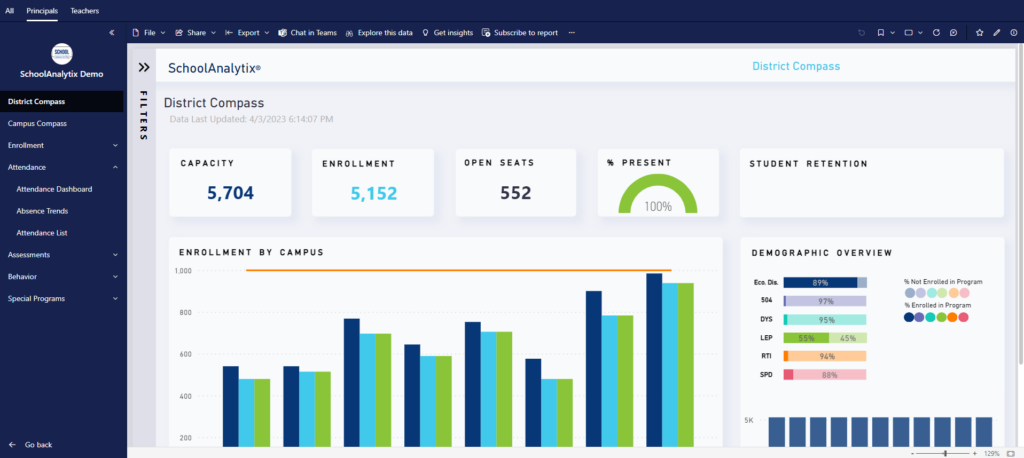In the dynamic landscape of education, effective management of school resources is paramount to providing high-quality education and fostering student success. School administrators face the complex task of balancing enrollment, capacity, open seats, student retention, and demographic factors to ensure equitable access to education and optimal learning environments for all students. In this article, we will explore strategies for optimizing school resources through comprehensive management of enrollment, capacity, open seats, student retention, and demographic overview.
Understanding the Challenges
Managing school resources involves addressing several interconnected challenges:
-
Enrollment Management: Schools must accurately forecast enrollment numbers and allocate resources to accommodate student needs while maintaining manageable class sizes.
-
Capacity Planning: Balancing capacity with enrollment is crucial to prevent overcrowding or underutilization of school facilities.
-
Open Seat Management: Maximizing open seats while minimizing dropout rates is essential to provide students with a range of course options and ensure access to preferred classes.
-
Student Retention: Retaining students is vital for maintaining stable enrollment numbers and fostering a supportive learning environment.
-
Demographic Considerations: Understanding demographic trends and addressing disparities in enrollment and retention is essential for promoting equity and inclusivity.
Strategies for Optimization
-
Data-Driven Decision Making: Utilize comprehensive data analysis to inform resource allocation decisions. Leverage enrollment data, demographic trends, and historical retention rates to anticipate future needs accurately.
-
Flexible Scheduling: Implement flexible scheduling options, such as block scheduling or blended learning models, to maximize classroom utilization and accommodate varying student preferences and needs.
-
Early Intervention Programs: Develop early intervention programs to identify and support students at risk of academic or behavioral challenges. Provide targeted interventions, such as tutoring or counseling services, to improve student retention rates.
-
Diverse Course Offerings: Expand course offerings to cater to diverse student interests and academic pathways. Regularly review and update the curriculum to align with changing educational standards and industry demands.
-
Community Engagement: Foster partnerships with community organizations, businesses, and local agencies to support student retention efforts. Collaborate on initiatives such as mentorship programs, internships, and extracurricular activities to enhance student engagement and retention.
-
Professional Development: Provide ongoing professional development opportunities for educators to enhance their instructional practices and support student success. Offer training on strategies for addressing diverse learning needs, fostering positive classroom environments, and promoting student engagement.
-
Technology Integration: Embrace technology to streamline enrollment processes, track student progress, and communicate with stakeholders. Implement student information systems, learning management platforms, and communication tools to enhance efficiency and transparency.
-
Targeted Support Services: Identify students facing socio-economic, academic, or behavioral challenges and provide targeted support services to address their needs. Collaborate with school counselors, social workers, and community agencies to offer resources such as academic tutoring, mental health counseling, and family support services.
-
Equity Initiatives: Implement equity-focused initiatives to address disparities in enrollment and retention. Develop outreach programs to engage underserved communities, provide access to resources and opportunities, and promote inclusivity and diversity.
-
Continuous Monitoring and Evaluation: Regularly monitor enrollment trends, capacity utilization, open seat availability, student retention rates, and demographic data. Evaluate the effectiveness of strategies and interventions and make adjustments as needed to optimize school resources and support student success.
Case Studies in Effective Resource Optimization
-
Flexible Scheduling at Greenfield High School: Greenfield High School implemented a flexible scheduling model that allows students to choose from a range of course options and customize their schedules to fit their academic and extracurricular interests. As a result, the school has seen increased student engagement, improved retention rates, and enhanced utilization of classroom resources.
-
Early Intervention Program at Oakridge Middle School: Oakridge Middle School developed an early intervention program to support students at risk of academic or behavioral challenges. The program provides targeted interventions such as academic tutoring, counseling services, and mentorship opportunities to help students overcome barriers to success. Since implementing the program, Oakridge Middle School has observed a significant decrease in dropout rates and an increase in student retention and academic achievement.
-
Equity Initiatives at Riverdale School District: Riverdale School District implemented equity-focused initiatives to address disparities in enrollment and retention among underserved communities. The district developed outreach programs, provided access to resources and support services, and implemented culturally responsive teaching practices to promote inclusivity and diversity. As a result, Riverdale School District has seen improved equity outcomes, increased student engagement, and enhanced community partnerships.
Conclusion
Optimizing school resources requires a multifaceted approach that addresses enrollment management, capacity planning, open seat management, student retention, and demographic considerations. By employing data-driven decision-making, implementing flexible scheduling options, developing targeted support services, and prioritizing equity initiatives, schools can effectively manage resources and support student success. Through continuous monitoring and evaluation, schools can identify areas for improvement and make adjustments to optimize school resources and enhance educational outcomes for all students.

